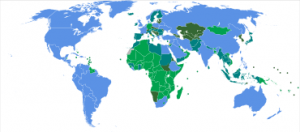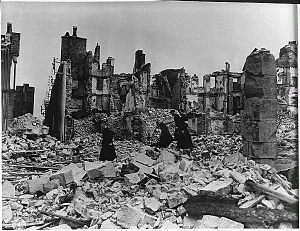The Bald Soprano was, in large part, inspired by Ionesco’s failed attempt at learning English using the Assimil method. The Assimil method, the most popular language learning tool in France at the time, teaches a new language by having the student copy down prescribed sentences with a translation alongside. It is the stock phrases and clichés of the sentences in the primer that first led to the idea of The Bald Soprano.
“I conscientiously copied out phrases from my manual in order to learn them by heart. Then I found, reading them over attentively, that I was learning not English but some very surprising truths…things that I may well have known before but had never thought seriously about or had forgotten, and suddenly it seemed to me as stupefying as it was indisputably true.”[1]
Ionesco had hoped to learn English to better serve him while working as a translator, but instead of learning a new language, he found himself instead reevaluating that which was indisputably true and so he set out to reveal how mechanical and thread-bare language had become in modern society.[2]
Ionesco often said that while The Bald Soprano arose from his frustrations while learning English, it just as easily could have come from the failure of learning a different language, because the play wasn’t a satire on English, but rather a “tragedy of language.”[3] Nevertheless, it was English that Ionesco decided to learn and so the question arises, “Why English?” By 1948, English had become the language to learn as the United States rose to be the first modern superpower of the 20th century after World War II as it dominated other countries in terms of military, economic and political strength. With the rise of the United States, English became the de facto language for business and trade, but also for politics thanks to the formation of the United Nations[4].

Map of the United Nations. The original member-states are shown in blue.
Img. Credit: https://en.wikipedia.org/wiki/Enlargement_of_the_United_Nations
With the United States dominating almost all aspects of global affairs immediately post-WWII, Ionesco, quite rightly, thought that knowing English would be helpful while working as a translator since there was now a great demand for documents and literature to be translated to and from English.
The Bald Soprano in terms of form and character, however, had deeper influences than the failure to learn English. Ionesco observed during his studies:
“For me, what had happened was a kind of collapse of reality. The words had turned into sounding shells devoid of meaning; the characters too, of course, had been emptied of psychology and the world appeared to me in an unearthly, perhaps its true, light, beyond understanding and governed by arbitrary laws.”[5]
This perceived collapse of reality coupled with the critique that the modern world had degenerated to “talking of the sake of talking” and words no longer held any real substance is the author’s anxiety that there was no longer any substantive communication in the modern world. Ionesco, like many of his contemporaries, was concerned with how humanity now interacted with each other in a world that had been torn apart by two world wars and was becoming dominated by machines.[6] This is reflected in the world of The Bald Soprano, as the characters devolve from stating the obvious in conversation to no longer being able to hold a conversation at all and is instead a series of frenzied non-sequiturs that cease to be able to convey meaning. The rapid pace of life and mechanization that began with the Industrial Revolution expanded after World War II as Europe rebuilt, with help from the US, after the devastation the war had wrought. Ionesco saw these factors as having replaced meaningful language with bare automatisms and used The Bald Soprano as a way of confronting a world where people were increasingly talking without saying anything and refusing to speak on the most important subjects.[7] Language was becoming composed of platitudes and automated responses- and each party refuses to listen to what the other was saying in favor of either making their next point or exiting the conversation.
Europe was a tumultuous place in the early 20th century. Populations moved to the cities in search of work in the growing industrial centers and two wars tore through the continent separated by a period of world-wide economic depression.

The results of a bombing in the French countryside during WWII.
Img. Credit: http://www.globeatwar.com/media-gallery/detail/41/166
Wars represent perhaps the greatest breakdown in human communication and lead to a tremendous loss of life and World Wars I and II did so on a scale never before seen by humanity. This was the perfect environment to foster a “tragedy of language” as it was the failure of communication on a global scale that created two devastating conflicts. Ionesco pushed back at this communicative failure in The Bald Soprano by showing how the devolution of communication lead to conflict between the Smiths and Martins and then, with the cyclical nature of the play, how the conflict was doomed to repeat itself in a world where no one was able to and didn’t care to communicate or understand each other.[8] IN this way, Ionesco was not only influenced by his personal experiences while learning English, but also through his experiences living through both world wars and saw firsthand exactly how devastating the failure of language can become.
[1] Ionesco, Eugène. Notes and Counternotes. Trans. Donald Watson. New York: Grove Press Inc., 1964. Print.
[2] Lane, Nancy. Understanding Eugène Ionesco. Columbia: University of South Carolina Press, 1994. Print.
[3] Ionesco, Eugène. Notes and Counternotes. Trans. Donald Watson. New York: Grove Press Inc., 1964. Print.
[4] Mastin, Luke. Language Issues: English as a Global Language. The History of English. 2011. Web. 12 May 2016.
[5] Ionesco, Eugène. Notes and Counternotes. Trans. Donald Watson. New York: Grove Press Inc., 1964. Print.
[6] Gaensbauer, Deborah B. Eugène Ionesco Revisited. New York: Twayne Publishers, 1996. Print.
[7] Bonnefoy, Claude. Conversations with Eugène Ionesco. Trans. Jan Dawson. New York: Holt, Rinehart and Winston, 1970. Print.
[8] Lane, Nancy. Understanding Eugène Ionesco. Columbia: University of South Carolina Press, 1994. Print.


